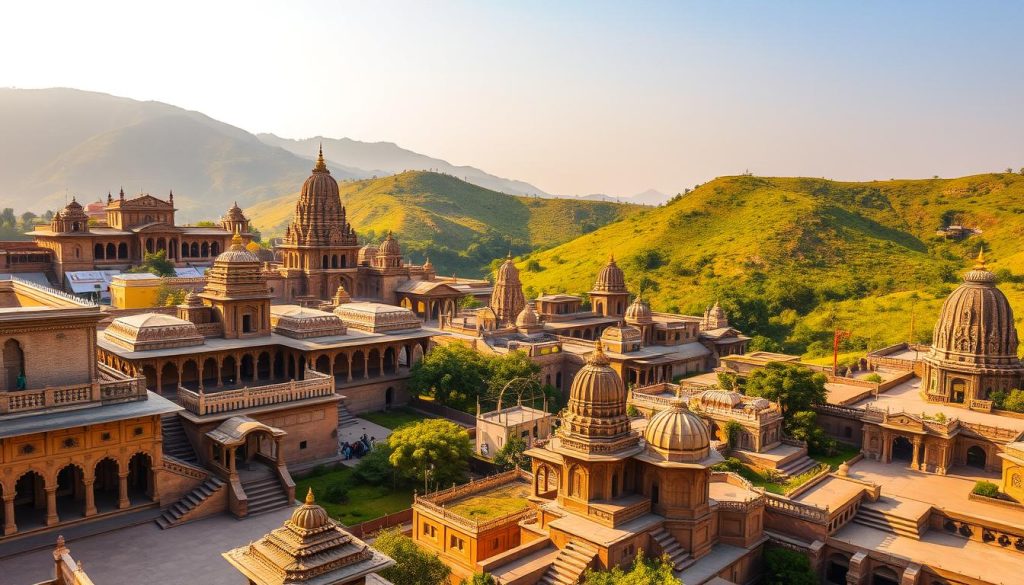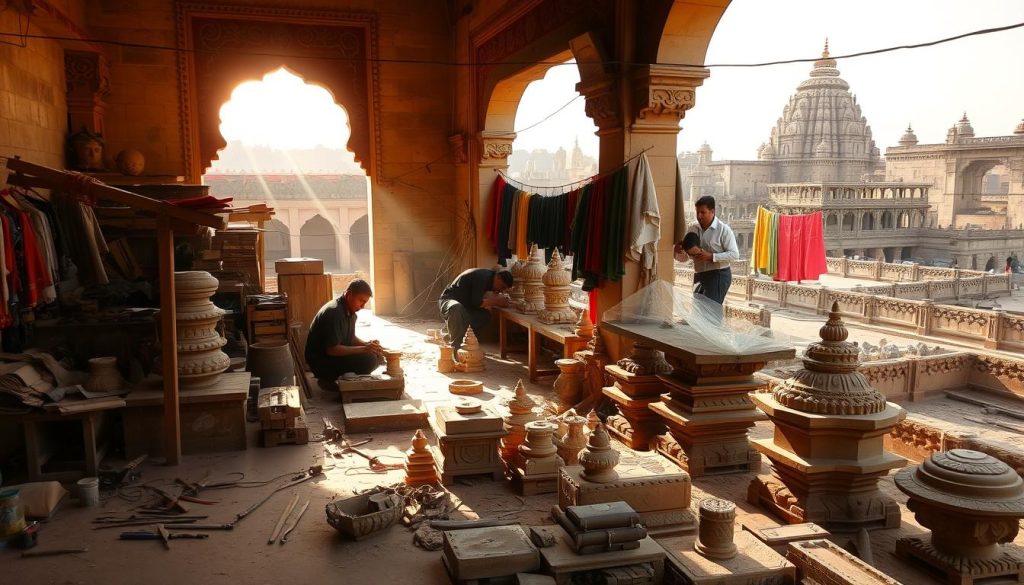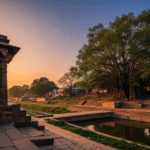Once hidden in time’s shadows, Champaner-Pavagadh Archaeological Park lies in Gujarat. Since its 2004 UNESCO honor, its story has come to light. This site shows history from the 8th to 14th centuries. It blends architectural wonders and cultural feats. Here, mosques, temples, and step wells tell tales of ancient mysteries.
Vadodara stands where past and present meet. It is home to Maharaja Sayajirao University of Baroda and a thriving Fashion Institute. The city draws smart people from all over India. Vadodara shines in education and has a growing industry scene. This attracts investors and experts from around the world.
Vadodara offers a journey through traditional Gujarati food that dazzles the taste buds. From filling thalis to sweet kulfi, the city’s food invites food lovers globally. Yet, Champaner-Pavagadh captivates history buffs. It blends myth with history, waiting for sunlight to share its stories with the world.
Key Takeaways:
- Champaner-Pavagadh’s ancient enigma unveiled through UNESCO’s recognition.
- The blend of spiritual and fortification structures reveals a rich tapestry of cultural history.
- Vadodara: A hub of educational, industrial, and technological evolution.
- Gujarati culinary delights contribute to the region’s unique charm and appeal.
- Champaner-Pavagadh lures with the promise of untold historical narratives awaiting revelation.
- Optimal periods to visit various Gujarat landmarks highlight the state’s year-round allure for travelers.
The Enigma of Champaner-Pavagadh’s Ancient Foundations
Champaner-Pavagadh Archaeological Park is a place full of history. It shows how building styles and cultural influences changed from the 8th to the 16th century. It was the first in Gujarat to become a UNESCO World Heritage site. People all over the world find its history fascinating.
Archaeological Marvels: From Mosques to Temples
This place has a mix of different religious buildings. You can see mosques like the Jami Masjid and the Saher-ki-Masjid. They were built in 1484 by Sultan Mahmud Begada. There are also ancient temples. The Kalika Mata Temple and the Lakulisa Temple are very old and important.
Heritage Designation: UNESCO World Heritage Status
Champaner-Pavagadh became a UNESCO World Heritage Site in 2004. This was a big moment. It showed how valuable the site is to the whole world. It also highlighted the need to keep protecting and studying it.
The 8th to 14th Century Impressions
The Champaner-Pavagadh archaeological park has a long history. It grew a lot under Sultan Mahmud Begada. He made Champaner the capital after winning Pavagadh Fort in 1484. A lot was built then, including 52 bazaars and strong walls that kept attackers away until 1535.
| Structure | Century | Purpose | Cultural Influence |
|---|---|---|---|
| Jami Masjid | 15th Century | Religious Gathering | Islamic |
| Kalika Mata Temple | 10th Century | Religious Worship | Hindu |
| Navlakha Kothar | 15th Century | Storage | Rajput |
| Lakulisa Temple | 10th Century | Religious Worship | Hindu |
| Saher-ki-Masjid | 15th Century | Private Worship | Islamic |
Mysterious history of Champaner-Pavagadh
The stories of Champaner-Pavagadh are captivating. They sit in Gujarat, India. Their tales echo through time. Looking into its past reveals a rich history of ups and downs.
This place shows the hidden stories of Champaner-Pavagadh. It was once a booming capital. Now, it quietly shows the impact of past events. From big fortresses to holy places, each building tells a story.
Experts think there is much more to find here. Digging up the past might show how people lived here. The work of archaeologists is putting the pieces together, showing a society that was forward-thinking and rich in culture.
| Aspect | Details | Impact on History |
|---|---|---|
| Architecture | A blend of Hindu and Islamic styles, prevalent in fortifications and residential structures. | Shows cultural synthesis and architectural innovation. |
| Archeological Finds | Tools, ornaments, and remnants of old dwellings. | Provides insights into daily life, trade, and economic conditions. |
| Spiritual Sites | Temples and mosques with intricate carvings. | Highlights the religious diversity and tolerance of the era. |
As we learn more about Champaner-Pavagadh, each find adds knowledge, shaping history anew. This place keeps surprising us, challenging our thoughts. It remains a mystery that touches both our minds and spirits.
Solving the Puzzle: Champaner-Pavagadh’s Historic Mysteries
The archaeological treasures of Champaner-Pavagadh are filled with secrets. They attract historians and adventurers into its depth. It gives us a special look into a past rich with stories and building wonders.
Hidden Tales in Stone: Understanding Structures
Every building in the Champaner-Pavagadh Archaeological Park tells a story. The Saher-ki-Masjid mosque shows the mix of Islamic and Hindu styles. Its design tells royal stories from long ago.
Legends and Myths: Stories from the Past
Champaner-Pavagadh’s story is rich with old tales. It has stories of battles and miracles, especially at the Kalika Mata temple. These tales make the place’s history even richer.
Unraveling Historical conundrums: The Discovery Process
Figuring out Champaner-Pavagadh’s mysteries takes lots of digging. Every found item or building part adds to the story of its grand past.
| Feature | Details | Historical Significance |
|---|---|---|
| Jami Masjid | Construction from 1484 to 1509 | Illustrates the peak of Sultan Mahmud Begada’s architectural patronage. |
| Kalika Mata Temple | 700 years old, located at the summit | Center of pilgrimage, intertwining religious devotion with ancient myths. |
| Markets of Champaner | 52 historical bazaars | Hub for international trade during Gujarat Sultanate’s golden age. |
| Rajput Fort Complex | Includes structures like Tankshala and Sadan Shah Gate | Represents the military and administrative prowess of Kichchi Chauhan Rajputs and later Sultan Begada. |
Each find and study at Champaner-Pavagadh helps solve its mysteries. It also links the past to now, showing a long line of human efforts and beautiful buildings.
Champaner-Pavagadh’s Secret Tunnels and Hidden Chambers
The mystery of Champaner-Pavagadh grows with stories of hidden tunnels and secret rooms. These underground paths are glimpses into history. They suggest hidden treasures and emergency exits, showing a network built for safety and secrets.
The cleverness of ancient builders shines in Champaner-Pavagadh’s maze of secrets. While mysteries remain, these hidden areas show a rich history waiting to be discovered. The secret passages prove the intriguing tales of Champaner-Pavagadh, attracting both explorers and scholars.
Learn more about Champaner-Pavagadh’s underground world from this detailed travel guide. It covers the fortress’s clever designs and fascinating stories, drawing tourists worldwide.
New digs reveal these spaces were more than escape routes or storage. They were key for daily life and battles in this ancient fortress. Every hidden spot might reveal stories of the area’s complex past.
As Gujarat’s first UNESCO World Heritage Site, Champaner-Pavagadh guards not just structures but historical stories too. The allure of its mysteries encourages both study and visits. The secrets of its stone walls and pathways keep inviting attention.
The beauty and stories within these concealed areas are central to Champaner-Pavagadh’s allure. With each visit and dig, more history is uncovered. The legendary place reveals its grand past bit by bit, through its hidden tunnels and rooms.
Emblems of Royalty: Champaner-Pavagadh’s Palatial Remnants
The Champaner-Pavagadh Archaeological Park is a place full of history. It shows the architectural brilliance and the rich past of medieval Gujarat. It is Gujarat’s first UNESCO World Heritage Site since 2004. The ruins here make people both admire and be curious.
The remains of the Champaner-Pavagadh palaces show us how powerful and wealthy ancient rulers were. These buildings, from strong forts to fancy palaces, tell us how royals lived in luxury. They loved grand designs and smart building plans.
Pride of the Kings: The Citadel and Royal Structures
The key part of Champaner-Pavagadh’s defenses, the citadel, and royal buildings are symbols of royal power. Different generations, from the Solankis to the Khichi Rajputs, have built impressive structures here. They show the skill of their times. The fort, taken over in 1484 by Mahmud Begada, has special military features like the Sadan Shah Gate.
Lost Luxury: Indicators of Ancient Opulence Rediscovered
Researchers have found many luxury items and detailed city plans. These findings tell us about the refined lifestyles of ancient rulers. They found rooms with beautiful decorations and objects showing a love for comfort. The Navlakha Kothar, a grand building, shows how important managing resources was for them.
Today, preserving these ruins helps us learn a lot about Champaner-Pavagadh’s history. This history includes many cultures, traditions, and architectural skill. By keeping these sites safe, we keep the story of Champaner-Pavagadh alive for everyone to learn from.
Cultural Syncretism: Champaner-Pavagadh’s Diverse Heritage
The Champaner-Pavagadh Archaeological Park is a special place. It’s more than just an ancient site or a tourist spot. It shows the blend of different cultures over the years. Here, the Champaner-Pavagadh cultural heritage and secrets are very clear.
This park mixes Islamic, Hindu, and Jain styles beautifully. You see it in the buildings and the traditions kept alive here. The Jami Masjid, Saher-ki-Masjid, and Pavagadh Hill temples show this mix. They blend artistic styles, showing how people can come together.
In 2004, Champaner-Pavagadh became Gujarat’s first UNESCO World Heritage Site. This place tells history’s stories through its artifacts and ruins. It once was a busy city with 52 markets. Then, it was forgotten but later found by British explorers.

The park is not just old buildings; it’s a lively place too. Pilgrims and tourists come here a lot. The Kalika Mata Temple is important for many, especially during festivals. This shows this heritage site is still very much alive.
| Era | Cultural Influence | Notable Monuments |
|---|---|---|
| 13th-14th Century | Hindu and Jain | Kalika Mata Temple, Jain temples |
| 15th-16th Century | Islamic (Gujarat Sultanate) | Jami Masjid, Saher-ki-Masjid |
| 19th Century | British Rediscovery | Archaeological excavation sites |
| 21st Century | Global Recognition | UNESCO World Heritage Site designation |
Champaner-Pavagadh’s story is about overcoming and renewal. It shows how cultures can come together and live in peace. This place shows us that being together in one society is possible. It’s an important part of the Champaner-Pavagadh cultural heritage.
The Lost Communities of Champaner-Pavagadh
Champaner-Pavagadh’s hidden past fascinates us. This area is full of secrets from long ago. The societies here were advanced for their time in living, culture, and building.
Vanished Civilizations: Traces of Forgotten Societies
Excavations in Champaner-Pavagadh reveal much about ancient life. Pottery and architecture teach us about their complex communities. Each find helps us understand more.
Socio-Cultural Discoveries: Excavating Daily Life
Digs and research in Champaner-Pavagadh tell us how these ancient people lived. They traded and interacted with others. Their society was thriving and organized well.
| Artifact | Description | Interpretation |
|---|---|---|
| Decorative Pottery | Ornate pottery pieces with unique geometric patterns | Indicates sophisticated artistry and possible trade goods |
| Stone Tools | Various tools including hammers and grinding instruments | Essential for daily tasks and resource processing |
| Metal Ornaments | Jewelry pieces made from bronze and silver | Reflects societal status and cultural practices |
The evidence from Champaner-Pavagadh shows its rich history. It also shows how diverse and adaptable the communities were. It makes us think about Champaner-Pavagadh’s mysterious past.
The Ancient Craftsmanship of Champaner-Pavagadh’s Artisans
The exquisite craftsmanship of Champaner-Pavagadh shows a mix of Champaner-Pavagadh artisan craftsmanship and Champaner-Pavagadh historical intrigue. This blend shows the artists’ great skills from the past. Today, it draws scholars and craftspeople who find inspiration and knowledge from its long-lasting legacy.
Art in Architecture: Intricate Carvings and Ornamentation
The Champaner-Pavagadh artisans were experts. Their skills shine in the beautiful carvings and ornamentation on old walls and columns. This highlights the Champaner-Pavagadh artisan craftsmanship. Art like the Jami Masjid carvings and the Kichchi Chauhan Fort’s strong structures tell stories of skill, creativity, and history.
Creative Continuity: Preserving Artisanal Legacies
Keeping Champaner-Pavagadh’s art and sites safe is key. This ensures the Champaner-Pavagadh historical intrigue stays alive. It also helps current craftspeople get inspired. The blend of Islamic, Hindu, and Jain styles from Sultan Mahmud Begada’s time shows the artisans’ high taste and cultural blend during Champaner-Pavagadh’s best days.

| Site | Architectural Style | Century | Key Feature |
|---|---|---|---|
| Jami Masjid | Islamic | 15th | Intricate stone carvings |
| Lakulisa Temple | Hindu | 10th | Carved figures of Hindu deities |
| Jain Temples | Jain | 13th-14th | White stone construction |
| Kalikamata Temple | Formerly Jain, now Hindu | Pre-15th, rope-way since 1986 | Located at 550 meters height |
The mix of religions in Champaner-Pavagadh’s architecture is important. It shows the area’s rich history and varied culture. Plus, it highlights the artisans’ amazing skills and open-hearted spirit. Their work is still admired and studied today, connecting the past and present through great art.
The Strategic Significance of Champaner-Pavagadh Throughout History
Champaner-Pavagadh is more than just a name in history. It was very important in the old days of India. This area’s fascinating stories are told by its ruins. They share tales of battles, trade, and the struggle for power. Being on the UNESCO World Heritage Sites list highlights its value.
Geopolitical Pivot: Champaner-Pavagadh in Warfare
Champaner-Pavagadh was key in battles because of where it is on the map. It sits high on a hill, making it a smart spot for forts. This spot helped protect against invaders and watch over the area. It also helped control trade paths. This tells us how important Champaner-Pavagadh was in old wars.
The Power Axis: Controlling Trade and Influence
Whoever controlled Champaner-Pavagadh ruled the trade routes. This let them shape the economy and politics. They could take trade taxes and set the terms. This made Champaner-Pavagadh a major commercial and political center long ago.
| Year | Event | Significance |
|---|---|---|
| 2004 | Induction into UNESCO World Heritage Sites | Recognition of historical and cultural significance |
| 15th Century | Construction of strategic fortifications | Enhanced defense and control over trade routes |
| Various Eras | Rule by different dynasties | Champaner-Pavagadh as a political and economic power center |
The Champaner-Pavagadh Archaeological Park has many Hindu and Jain temples, mosques, and strongholds. Each of these shows the mix of cultures in the area. They help us understand its rich and complex history better.
Conclusion
Champaner-Pavagadh Archaeological Park tells a lot about India’s rich past. Since 2004, it has been a UNESCO World Heritage site. It’s known for history and a mix of cultures.
This place isn’t just an old treasure. It also shines a light on Indian heritage. We see this in art and old plans.
The mystery of Champaner-Pavagadh is about more than old buildings. It connects to India’s growth today. This is seen in Vadodara’s chemical and drug sectors.
Places like The Maharaja Sayajirao University of Baroda help too. They grow culture and learning. They help us understand Champaner-Pavagadh’s secrets.
Modern progress is close to ancient wonders. This mix reminds us of the old and the new together. Champaner-Pavagadh’s old stories live on in our world today.
It shows our love for exploring and learning. It makes us think about old times and the future. This place is really inspiring for everyone.
FAQ
What aspects contribute to Champaner-Pavagadh’s mysterious history?
Its ancient roots, mix of myths and real history, and secret structures and tunnels make Champaner-Pavagadh mysterious. Mosques and temples here show the area’s diverse cultural past.
What is the significance of the Champaner-Pavagadh Archaeological Park?
This park is important because it has ancient remains from the 8th to 14th centuries. It has old walls, palaces, and worship places. These show different cultures together. This mixture made it a UNESCO World Heritage Site.
How do the ancient structures at Champaner-Pavagadh reveal its history?
These buildings tell us about the past life, politics, art, and beliefs. They have architectural pieces and items from many times and cultures. This helps experts understand the site’s history and importance.
Are there any legends or myths associated with Champaner-Pavagadh?
Yes, there are stories of battles, heroes, and miracles at Champaner-Pavagadh. These stories add to the place’s historical story.
What secrets do the hidden tunnels and chambers of Champaner-Pavagadh hold?
The hidden tunnels and rooms might have hidden treasures and escape routes. They show a secret network built for safety and storage, used by old residents for defense and storing things.
What do Champaner-Pavagadh’s palaces indicate about its past rulers?
The ruins of its palaces show how royal and grand the old rulers lived. Their fancy decorations and smart city designs show their wealth and power.
How does Champaner-Pavagadh reflect cultural syncretism?
Its buildings show a mix of Islamic and Hindu designs. This mix tells us about the different groups and religions in the area’s past.
What have researchers learned about the lost communities of Champaner-Pavagadh?
Experts have learned about the people’s lives, work, trade, and social setup from old things and remains of houses and public places.
What does the craftsmanship of Champaner-Pavagadh reveal about its artisans?
The detailed work and designs show the skill and creativity of the old artisans. Their work has inspired many craftsmen after them.
Why was Champaner-Pavagadh’s location strategically significant in history?
Its high location helped rulers defend, watch the area, and control trade paths. This place was very important for power in the region through history.










